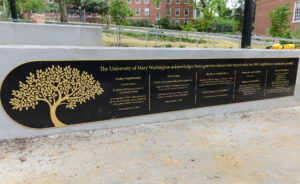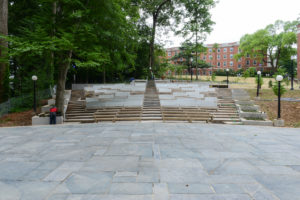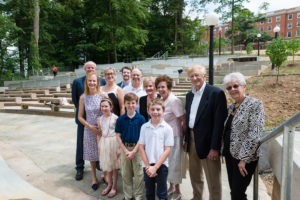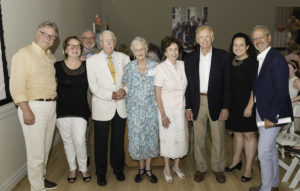Saturday’s dedication of the Heslep Amphitheatre and Morris Stage began a new chapter in the life of one of Mary Washington’s oldest and most endearing sites.

The event took place during Reunion Weekend 2018, 95 years after the Amphitheatre’s original 1923 dedication. It marked the near conclusion of a meticulous $3 million renovation project funded largely by alumni passionate about the century-old site. The project was part of the $50-million Mary Washington First Campaign.
Built into a nook in the woods off Sunken Road, the Amphitheatre has long been a student favorite, at varying times throughout history, home to commencement exercises, May Day ceremonies, impromptu outdoor study sessions, plays, concerts, even weddings. It’s been expanded, neglected and revived through the decades, but it’s always been cherished.
Originally a simple wooden structure and benches, it was redone in steel and concrete during the 1920s. Through the years, the stage was enlarged, the seating expanded, and elements added – a pergola and columns, even dressing rooms and a lighting system.

Exposed to the elements, though, the Amphitheatre began to slip, however gradually, into varying stages of disrepair, at times called “decrepit, “lopsided,” even “treacherous.” By the late 1990s, the Board of Visitors allocated $40,000 to make the site safe. In more recent years, though, its condition had become dire. In 2011, for example, crews removed fallen cast stone columns, and a 2012 summer storm sent two trees toppling onto the stage.
Faced with the possibility of forever losing this beloved site, UMW launched a restoration campaign in 2014. The goal was to return the amphitheater to its historical glory, increase accessibility, upgrade infrastructure, enhance flexibility and add restroom facilities – all while preserving the pristine park-like setting.Just a year later, Mary Washington met criteria for receiving a $125,000 challenge grant from the Richmond-based Mary Morton Parsons Foundation. A 2016 groundbreaking ceremony was held, and site preparation began last July.

Glavé & Holmes Architecture of Richmond took on the project, surveying the surrounding woodland to preserve healthy trees and researching historic drawings. They repaired and reconstructed the Amphitheatre’s damaged and missing pieces “to put back together the history of what was originally built,” said Glavé principal Jill Nolt.
Working to the Secretary of the Interior’s standards, the firm restored the site’s colonnades, pergolas and balustrade; added weather-resilient benches with back supports; built restroom facilities behind Trinkle Hall; and installed ADA accessibility accommodations.
The Amphitheatre’s new namesakes, Donald B. and Josephine McPherson Heslep ’56, longtime supporters of UMW initiatives, contributed $1.25 million to the renovation project. The site’s Morris Stage was named for former May Queen Marceline “Marcy” Weatherly Morris and Elmer “Juney” Morris Jr., 1950 graduates who made a significant gift to the campaign.The couple called the dedication event “one of the most memorable days of our lives.”

Major donors also include Robert S. Jr. and Alice Andrews Jepson ’64 and other enthusiastic Mary Washington grads.
“This cherished landmark is important to generations of Mary Washington alumni and members of the local community,” said UMW President Troy Paino. Mary Washington Historian and Distinguished Professor Emeritus of History William B. Crawley Jr. delivered remarks about the history of the Amphitheatre.
Among the nearly 200 guests in attendance was Mary Katherine Greenlaw ’61, whose mother, Louise Garnett Goodwin ’30 served on the May Court during her college years.
A second dedication, this one for UMW’s new Zen garden, just up the hill from the Amphitheatre, also took place Saturday.
Three giant boulders form the focal point of the Japanese-inspired site, outside Trinkle Hall’s Leidecker Center for Asian Studies. A bed of raked pebbles topped with crushed granite represents ripples of water, and hand-cut bamboo strips form an arched fencing.
The garden, which forms a sort of an entrance to the Amphitheatre, provides a spot where students, faculty and staff can slow down, shrug off negativity and reflect. It also supports campus initiatives in wellness, contemplation and multiculturalism, said Assistant Professor of Religion Dan Hirshberg.
“Genuine appreciation for diverse cultures is a fundamental value in the liberal arts,” Hirshberg said, “and something we’ve always stressed as a primary function of this garden.”